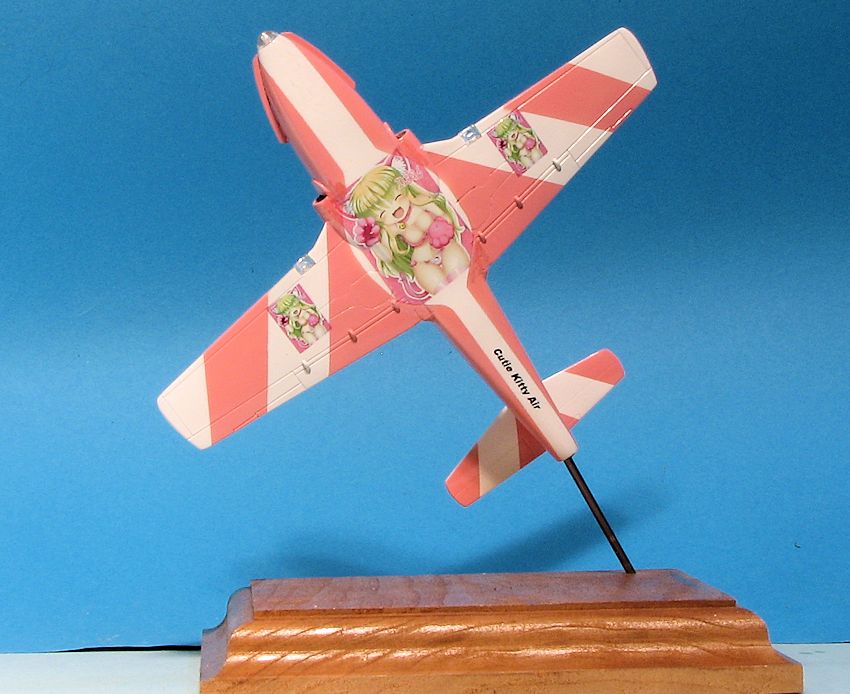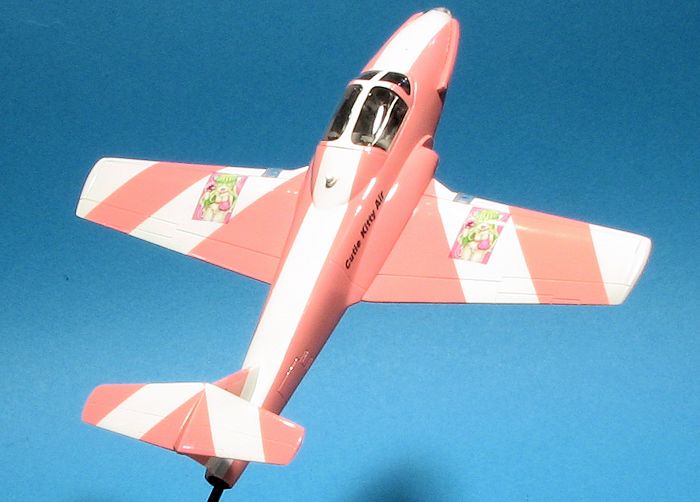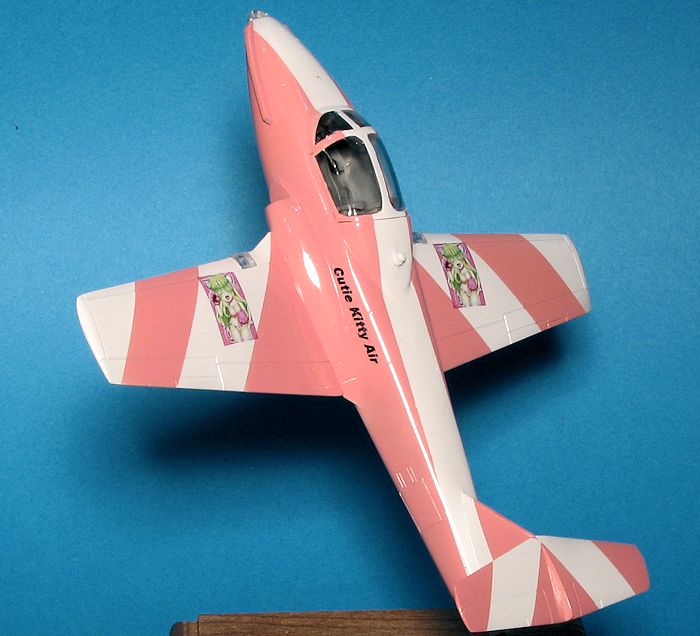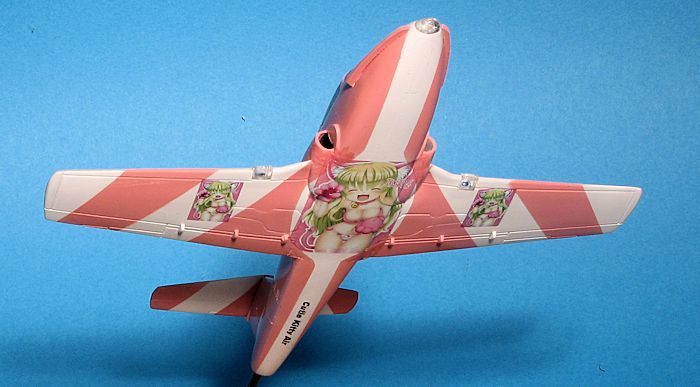
| KIT #: | HC 1364 |
| PRICE: | $7.49 SRP when new |
| DECALS: | Two options |
| REVIEWER: | Scott Van Aken |
| NOTES: |

| HISTORY |
The Canadair CT-114 Tutor (company model CL-41) was the Royal Canadian Air Force (RCAF), and later Canadian Forces, standard jet trainer, between the early 1960s and 2000. Designed and built by Canadair, it was ordered in September 1961.
The Tutor served as the Canadian Forces primary jet trainer until it was replaced by the CT-155 Hawk and CT-156 Harvard II in 2000. The CL-41G model supplied to Malaysia was built as a ground-attack aircraft. The Tutor is currently still used by the Snowbirds aerobatics team.
| THE KIT |
 This is apparently the only injection molded kit of this aircraft available in this scale. There was one done in resin in 1/144 scale, but it seems that there isn't a huge demand for the type amongst modelers. It has been released three different times by Hobbycraft with other boxings including markings for the Snowbirds.
This is apparently the only injection molded kit of this aircraft available in this scale. There was one done in resin in 1/144 scale, but it seems that there isn't a huge demand for the type amongst modelers. It has been released three different times by Hobbycraft with other boxings including markings for the Snowbirds.
My kit suffered from basement flooding back in 1997 when we had a deluge and six days without power so I couldn't pump the water out. A generator was soon purchased after the big box stores got in a restock. I pretty well figured the decals would be toast and so they were. Still, the kit was shrink wrapped and I figured the plastic would be ok. Opening it for an upcoming project, I discovered a bunch of mold on the paper parts of the package so those were quickly tossed out. However, the plastic was still good that is what was important to me.
Hobbycraft obviously wanted this kit to be a pretty quick build. There is a cockpit tub with instrument panel, two control sticks and two seat shapes. There is no indication that one needs nose weight, but I'd use some. The wing is a single piece with the gear wells molded in place. The nose gear well is incorporated into the fuselage halves. The tailplane is also a single mold. There are separate nose strakes and in some markings schemes, one will probably want to install those after the decals.
 Landing gear each have separate wheels and the gear doors will need to be cut for the 'down' position. There is no option for a raised gear shown nor is a display stand provided. A two piece windscreen/canopy is offered, but again, it is designed for the closed position as there is no canopy actuating mechanism. Other bits are a pair of landing lights, two travel pods or fuel tanks for under the fuselage and a two part nose section with the lower half clear to represent the landing light.
Landing gear each have separate wheels and the gear doors will need to be cut for the 'down' position. There is no option for a raised gear shown nor is a display stand provided. A two piece windscreen/canopy is offered, but again, it is designed for the closed position as there is no canopy actuating mechanism. Other bits are a pair of landing lights, two travel pods or fuel tanks for under the fuselage and a two part nose section with the lower half clear to represent the landing light.
Instructions are on a folded sheet of paper with five construction drawings. No color information is provided for the interior or wheel wells or gear legs. There are markings provided for three planes. Two are overall aluminum lacquer or bare metal with red areas as assigned to 2 CFFTS in 1985 and 1996. These differ in the 'Canada' markings with the older one having the squadron badge on the rudder. The third option is for a CL-41G of the Malaysian Air Force in green over light grey. My decals were toast due to water damage, but since this is a rather early boxing, I would guess that even perfect decals would prove to be useless.
| CONSTRUCTION |
My first decision on this one was to build it wheels up. The kit already had the gear doors molded closed so that, along with the rather soft detailing on the gear and wheels helped me to make that decision. After removing several parts from the sprue and making 'tsk' noises at how crude the kit was compared to what is available today, I started on the interior. This meant painting it dark gull grey and cementing in the various  bits. Seats fit fairly well, but I ran into issues on the control sticks. These are on the sprue in such a way that any flexing of the sprue will snap them in half. As a result, these were 'pre-broken' on the sprues. I cemented the lower sections in place and when all was dry, attached the upper bits, which thanks to the thinness of the plastic, were soon broken off and lost. The instrument panel was painted and glued onto the floor of the cockpit. There are small alignment blocks up against which these are to fit. They were both about 20 degrees off axis.
bits. Seats fit fairly well, but I ran into issues on the control sticks. These are on the sprue in such a way that any flexing of the sprue will snap them in half. As a result, these were 'pre-broken' on the sprues. I cemented the lower sections in place and when all was dry, attached the upper bits, which thanks to the thinness of the plastic, were soon broken off and lost. The instrument panel was painted and glued onto the floor of the cockpit. There are small alignment blocks up against which these are to fit. They were both about 20 degrees off axis.
The fuselage halves were glued together without any fuss aside from the usual need for filler. I found that all the gear doors were a bit oversize and so needed a bit of trimming to fit. The wing section was then glued in place and I opened up the intakes a bit more with a motor tool. After more filler, the tailplane was glued on. I left off the nose strakes until painting. They are grossly over-thick and those wanting to do a proper model will want to replace them with plastic card. I then attached the clear bits. The canopy section wouldn't fit over the too-tall seats so those were sanded down. Attempts at installing pilot figures came to naught as all the ones I had were far too large to fit. I was also somewhat dismayed at the lack of a proper instrument panel anti-glare panel, but wasn't going to go through the work of making one. The windscreen and canopy did fit well once the seat issue was taken care of.
| COLORS & MARKINGS |
I thought I'd do a sunburst pattern of pink and white for this one. First, several coats of Tamiya X-1 white were sprayed on and then after a few days of drying, I masked the airframe and used Humbrol pink. I pulled off the masking tape and was pleased with the result. Then it was time to hunt up some markings. I finally decided on an appropriate offering and so made the set using my inkjet printer and clear decal sheet (since I was going to put these markings over a white background.
| FINAL CONSTRUCTION |
 Once the decals were on, I gave the airframe a nice clear coat and looked around for a base on which to place it. Locating something suitable, I then hunted up something to use to mount the aircraft. I decided to use 3/32 piano wire and so drilled at hole in the exhaust and in the corner of a base that I had. The base was given several coats of clear and the wire was inserted in place. Back at the jet, the clear nose and two wing landing lights were installed. Interestingly, the wing lights were each different sizes and it took a bit of test fitting to figure out which one fit where and in which way. Eventually that was worked out and the masking taken off the canopy. The last steps were to pull off the masking and install it on its base.
Once the decals were on, I gave the airframe a nice clear coat and looked around for a base on which to place it. Locating something suitable, I then hunted up something to use to mount the aircraft. I decided to use 3/32 piano wire and so drilled at hole in the exhaust and in the corner of a base that I had. The base was given several coats of clear and the wire was inserted in place. Back at the jet, the clear nose and two wing landing lights were installed. Interestingly, the wing lights were each different sizes and it took a bit of test fitting to figure out which one fit where and in which way. Eventually that was worked out and the masking taken off the canopy. The last steps were to pull off the masking and install it on its base.
| CONCLUSIONS |
I have to confess that if it wasn't for the Greg Ewald group build, this kit would have stayed unbuilt, mostly due to the lack of decals for it. As it was, I got a chance to build a kit I'd never done and make it in an interesting scheme as well.
| REFERENCES |
http://en.wikipedia.org/wiki/CT-114_Tutor
April 2014 Thanks to me for the review kit. If you would like your product reviewed fairly and fairly quickly, please contact the editor or see other details in the